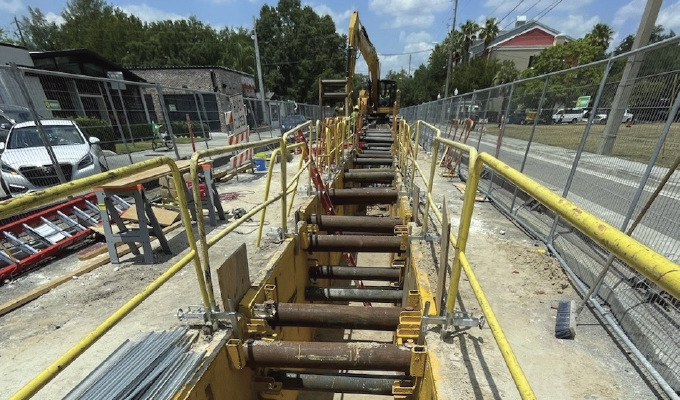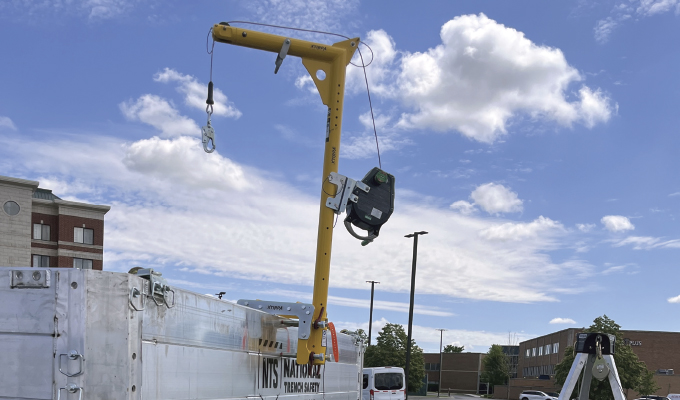National Trench Safety’s (NTS) Director of Strategic Operations, Eric Juhl, traveled to the United Kingdom to visit vendors who manufacture large hydraulic bracing. But Juhl ended up coming away with new ideas on how to keep workers safe while also growing the trench safety business back in the United States in two areas: fall protection and rescue systems for excavations.
According to Juhl, it was impressive that nearly every job site in the U.K. had a guardrail around it, no matter where the excavation. In addition, nearly all of them had a davit arm attached to the steel protective system in the ground, whether it be a trench box, slide rail, or sheeting. One can easily assume there are less accidents of workers falling into excavations in the U.K. in comparison with the number of accidents in the United States.
Unfortunately, stats as recent as 2022 are surprising. In the U.K., there were 40 workplace deaths due to falls from a height. In the United States, a staggering 865 workers died in falls and hundreds of thousands were injured badly enough to require days off work. When you dig into the numbers, falls make up the second highest cause of worker deaths only behind transportation deaths in the United States. The National Institute for Occupational Safety & Health (NIOSH) mentions unprotected edges as a major area of concern. OSHA’s construction standard, 1926 Subpart M, deals with fall protection and specifies that when workers are exposed to vertical drops of six feet or more, the employer is required to provide fall protection in one of three ways:
- Placing guardrails around the hazard area.
- Deploying safety nets.
- Providing personal fall arrest systems for each employee.
The guardrail isn’t a new concept in the United States, however, Juhl notes several challenges that can occur. Systems can be outdated, too heavy, not stacked or organized, or not readily available. Juhl explains situations in which systems are shipped to jobsites, but workers end up leaving them in a pile to never move from the spot they were delivered. Sometimes, guardrail systems require the contractor to buy lumber to use as the “rails.” According to Juhl, the method has been inefficient and inconvenient, and there was an opportunity to create a new system.

G-RAIL TRENCH BOX RECEIVER
Juhl got in contact with Guardian Fall Protection since they had been strategic partners on other products, but now producing a new guardrail system together was being discussed. As a result of the collaboration, the Guardian’s G-rail Trench Box Receiver was born, which integrates Guardian’s G-rails. The receiver fits on wall thicknesses of 0.25 in. to 8 in. thick and weighs only 14 lbs. As for the guardrails themselves, they come in 6-, 8-, 10- and 12-ft. sections and have a storage system for easy organization and transport. The product is OSHA 1910.29 and OSHA 1926.502 compliant.
With the introduction of Guardian’s G-rail Trench Box Receiver, the opportunity to grow the product line and make conditions safer for thousands of laborers working near excavations had just begun. The most important part of creating the trench box receiver was to ensure it was easy to use and lightweight. Both goals were accomplished. While working on improving guardrails, there was an opportunity to create a better mousetrap with rescue systems in excavations. Tripod and winches were being used regularly for manholes and other easily accessible entries. But when it came to trench protective systems, there were very few good options.
Juhl connected with MSA, another safety partner to NTS that supplies gas monitors, tripod and winch systems, and harnesses and head protection. Together with XTIRPA, a new davit arm and trench box adapter was designed. The adapter weighs 40 pounds and ranges from 2 to 10.5 in. wide. Equipped with a workman rescuer, fall arrest protection is ensured, but also quick retraction/rescue of a worker in need. This product only takes minutes to set up and ensures another level of safety. These two life-saving tools are available to buy or rent in the market now.
Hazards are always going to exist on construction sites, especially when dealing with excavations. However, the more equipped jobsites are, the more workers can be guaranteed to go home the same way they came to work — alive.
FOR MORE INFORMATION
This article was contributed by National Trench Safety, a National Utility Contractors Association (NUCA) National Partner. For more, visit National Trench Safety’s official website at www.ntsafety.com.


